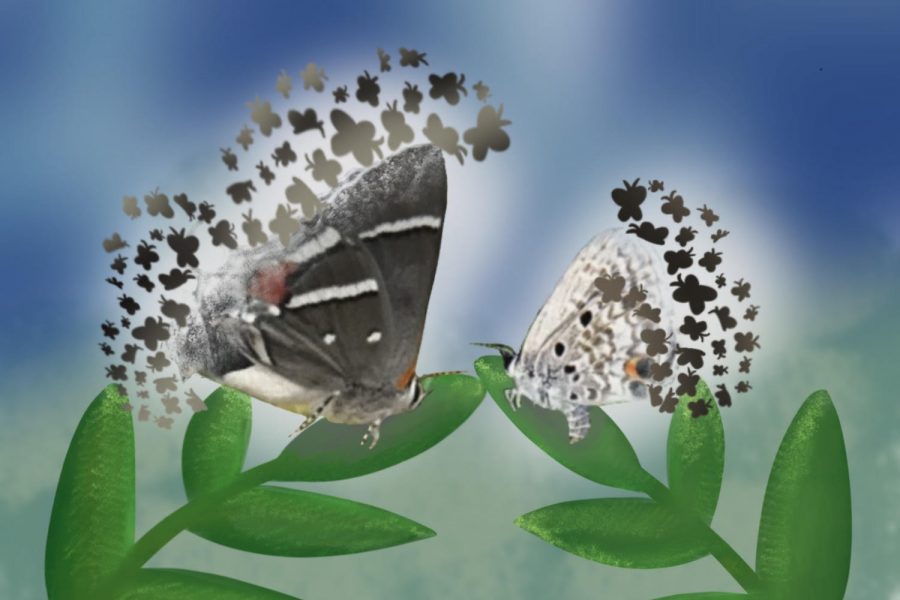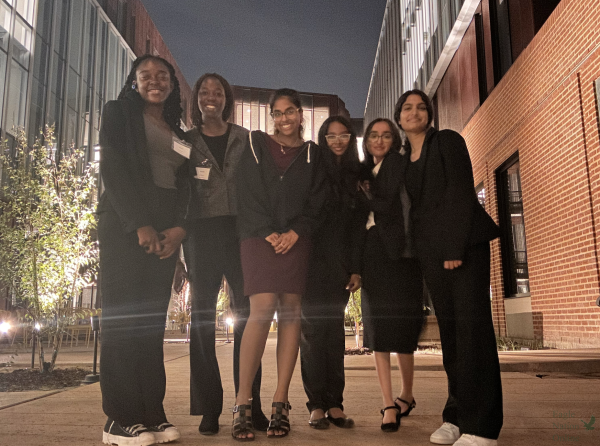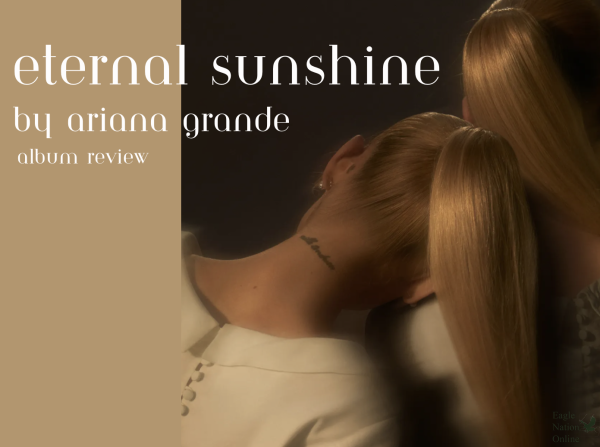Column: Butterfly species face extinction from climate change
The two butterfly species are pictured in this graphic with an abstract background. “I love this graphic because it uses cooler colors to show the docile nature of the butterflies.” Kalyani Rao said. “Julia Chung really did a great job portraying the beauty of the butterflies in their natural habitat.” Graphic used with permission from creator Julia Chung.
With COVID-19, upcoming elections, and more, it appears as though we have forgotten about the butterflies. However, things we used to think were impossible to worry about seem to be occurring more and more. The most recent reminder of global warming is the impending extinction of two butterfly species in Miami, which are the Miami Blues and Bartram’s scrub-hairstreak butterflies. Miami blues are a gorgeous metallic blue with a silver-grey underside, only reaching about .39 of an inch when fully grown. Bartram’s scrub-hairstreak butterflies are only about an inch long when fully grown, and they can be spotted by their daring wing patterns of black and white lines splashed with orange.
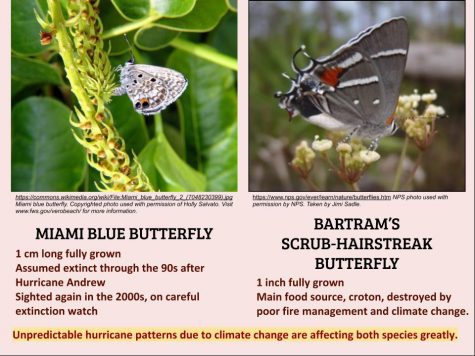
According to biologicaldiversity.org, “After Hurricane Andrew ripped through South Florida in 1992, the already-scarce Miami blue butterfly almost went extinct: No one recorded a single sighting for years.” However, the butterflies reappeared in the 2000s and scientists in Florida have made careful efforts to keep a population maintained.
This may not seem important to many of us, but it is a warning to our community that we are not taking climate change seriously enough. “Miami blues (Cyclargus thomasi bethunebakeri) once flourished along Florida’s beach berms, and Bartram’s scrub-hairstreak (Strymon acis bartrami) flitted about in pine rockland forests along the Miami rock ridge, which underlies much of southeast Florida,” postdoctoral researcher in NC State’s Department of Biological Sciences Erica Henry said. “Now, nearly all of the habitat for both of these butterflies has disappeared under the city of Miami.”
The reason these butterflies have gone from numbers in the tens of thousands to almost extinct in a matter of months is rampant hurricanes. As carbon dioxide in the atmosphere grows due to climate change, hurricanes are getting bigger, meaning they are causing more destruction. The chances of regular storms turning into hurricanes are increasing as well.
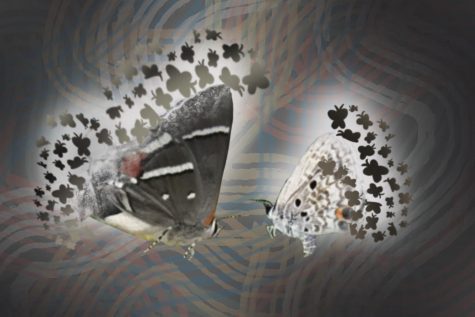
The species are also struggling due to the changing vegetation patterns on islands due to climate change. The Bartram’s scrub-hairstreak butterflies were suffering from climate change even before Hurricane Irma– the main evergreen shrub they rely on for food, pineland croton, is disappearing from areas due to the changing fire patterns. Animals that rely on consistent burn and regrow patterns from vegetation are suffering due to climate change, making these patterns become unpredictable. Fires are occurring less due to human populations increasing as well. This is worse than you would assume, because the eventual wildfires that occur will be much worse and much more damaging than the smaller ones that usually come and go throughout the area, due to the forest being overgrown.
Hurricane Irma wiped out 60-70% of croton plants in the area. Bartram’s scrub-hairstreak butterflies have completely disappeared from Big Pine Key in Florida, the area where these butterflies were monitored. Both Hurricane Irma and poor fire management were the cause of this extinction.
The final message? In my opinion, our main job as a community is to spread awareness. If the public community shows a demand for better wildlife services and climate change control, we can play a big role in the fight, saving thousands of species. We have many things we need to focus on, as COVID-19 and upcoming elections are important pieces, but don’t let us forget about all of the animals that share the earth with us–we all need to look out for each other.
Your donation will support the student journalists of Prosper High School. Your contribution will allow us to purchase equipment and cover our annual website hosting costs.

Honors, Experience and Awards:
5 Best of Sno publications.
5th place in Copy Editing, district UIL meet 2021
Honorable mention- Podcast interview, 2021 TAJE Fall Fiesta
UIL Journalist 2020-2021, 2021-2022
Quill and Scroll Society member 2021-2022
1st place in Copy Editing for CENTEX UIL meet 2021-2022
3rd place in Copy Editing for Aubrey UIL meet 2022
2nd place in Copy Editing for NorTex UIL District meet 2022
National Silver award for poetry from the Scholastic Art & Writing organization
National Recognition Award from College Board
AP Scholar with Distinction Award
2 Best in Texas News & Broadcast Awards, 2022: Personal Opinion Column- Honorable Mention, News Story- Honorable Mention
President of the Classic Book Club, 2020-onwards
Member of the National Spanish Honors Society (NSHS)
PHS Award for Academic Excellence in Newspaper II, 2022
Dean’s Scholarship for Cornell University Pre -College Program
Sibley Scholarship for Brown University Pre -College Program
CIEE Global Navigator Scholarship

Julia is a senior at Prosper High School. She was born in South Korea but had lived in Vancouver, Canada, for three years before moving to Prosper in the summer of 2019. This is her second year on staff. She works to improve design elements of each page of the website. Julia designed ENO's nameplate for this year. She is also the Vice President of the National Art Honor Society. Julia hopes to major in graphic design or art therapy. Click HERE to view her portfolio.
Honors & Awards:
1 Best of SNO publication
Academic All-State Prosper HS Men's Soccer, 1st Team 2022
Texas Association of Journalism Educators (TAJE) Best of Texas, "Excellent" in Photo Gallery, 2022
Texas Association of Journalism Educators (TAJE) Best of Texas, "Honorable Mention" in Photo Gallery, 2022
Visual Arts Scholastic Event (VASE) Texas Art Education Association (TAEA), 6 medals 2019, 2020, 2022
Association of Texas Photography Instructors (ATPI) Fall Photo Contest, 2 Honorable Mention in "Travel" 2020, 2021
Prosper High School Student of the Month, "AP 2D Design & National Art Honor Society" November 2021
Prosper High School Student of the Month, "Newspaper Graphic Design" October 2021
Prosper High School Academic Awards, "Graphic Design & Illustration II" Student of the year 2021
Quill & Scroll Writing, Photo & Multimedia Contest Awards, 3rd place in "Profile Portrait" 2020
Association of Texas Photography Instructors (ATPI) Fall Photo Contest, Honorable Mention in "Travel" 2020
Burnaby Mountain Secondary School Top Student of Fine Arts Award 2018, 2019
Prosper HS Men's Soccer 2022, Manager
National Art Honor Society 2019-present, Vice President
National Honor Society 2020-present, Member
Mu Alpha Theta 2021-present, Member
Science National Honor Society 2021-present, Member
Psi Alpha Psychology Honor Society 2021-present, Member
Rho Kappa 2021-present, Member
Diverse & Inclusive Society 2021-present, Member
Adobe Illustrator Certificate 2020
Adobe Photoshop Certificate 2019


